TELKOMNIKA Telecommunication Computing Electronics and Control
Vol. 21, No. 2, April 2023, pp. 382 389
ISSN: 1693-6930, DOI: 10.12928/TELKOMNIKA.v21i2.22746

TELKOMNIKA Telecommunication Computing Electronics and Control
Vol. 21, No. 2, April 2023, pp. 382 389
ISSN: 1693-6930, DOI: 10.12928/TELKOMNIKA.v21i2.22746
Dedi Irawan1, Khaikal Ramadhan2 , Toto Saktioto2, Azwir Marwin2
1Department of Physics Education, FKIP, Universitas Riau, Pekanbaru, Indonesia
2Department of Physics, Faculty of Mathematics and Natural Sciences, Universitas Riau, Pekanbaru, Indonesia
Article Info
Article history:
Received Jan 05, 2022
Revised Jun 22, 2022
Accepted Oct 26, 2022
Keywords:

FBG coating
FEM
Optical sensor
Sensitivity
ABSTRACT
Fiber Bragg grating (FBG) with silica material has limitations in measuring mechanical quantities such as strain and temperature, this happens because silica fibers are easy to break at higher transverse or axial strains. This deficiency can be overcome in several ways, one of which is by coating the silica FBG with a coating material made of metal or polymer. In this research, the FBG sensor has been designed by poly methyl methacrylate (PMMA)-coated FBG and silica. The finite element method (FEM) is used to analyze the electric field distribution on the surface of PMMA coated FBG with a coating thickness of 20 µm. Furthermore, the sensitivity of each coated FBG as a temperature sensor was measured in the range of 25 ℃ to 85 ℃ using coupled mode theory (CMT). From the design and analysis of coated FBG, it was found that FBG coated with PMMA material had the highest sensitivity of 395.73pm/℃. However, the FBG sensor coated with silica material has a sensitivity of 13.73 pm/℃. the shift obtained is also linear along with the temperature of 25 ℃ to 85 ℃
This is an open access article under the CC BY-SA license.
Corresponding Author:
Dedi IrawanDepartment of Physics Education, FKIP, Universitas Riau
Kampus Bina Widya Km 12.5, Simpang Baru, Pekanbaru 28293, Indonesia
Email: dedi.irawan@lecturer.unri.ac.id
Sensing with optical phenomena has become an advanced technology that is developing in various fields, ranging from industrial technology [1] to the health of material structures [2] to human health [3]. In many advanced applications where size, remote measurement, the accuracy factor, and the large shift of the Bragg wavelength are critical, optical fiber-based sensing techniques can provide revolutionary solutions that will give rise to advanced technologies utilizing the photon phenomenon. Therefore, fiber optic sensing technology is being developed as a future technology that is currently implemented in various applications. This technology continues to grow rapidly and widely. Several new types of fiber sensors are emerging, and several fiber sensing technologies are mature and have been commercially produced and used in specific applications. As light-wave technology becomes a new technology enabling advanced applications, fiber optic sensors can play an integral part in this development.
The application of optical fiber sensors, especially fiber Bragg grating (FBG) has increased because of its special capabilities such as immunity to electromagnetic wave interference, light-weight, small size, low cost and coded by wavelength. FBG sensor has a good response in physical quantities such as temperature, pressure, strain, velocity, and force. The commercials FBG sensors are usually made of silica and for some applications silica FBG can be relied on. The silica fiber has good optical properties such as low optical attenuation [4], [5] This material has become favorable material dispersion for communication and sensor applications [6]
Journal homepage: http://telkomnika.uad.ac.id
However, some properties of silica materials such as strain, temperature, or force sensor commonly used in FBG. In addition mechanical parameters also can make silica fibers unable to withstand extreme conditions and can easily break under strain [7] although FBG with silica fiber material has advantages such as basically this fiber has a layer that can increase mechanical resistance. So, in terms of monitoring high temperature and cryogenic temperature, silica FBG should be treated differently by coating some polymeric materials or metallic materials to obtain good performance and desired sensitivity.
The weakness of the silica optical fiber material under external influences can be overcome by a protective layer, the layer that can usually be used on the fiber is a layer with metal and polymer materials. The metal coating yield good FBG’s performance as a temperature sensor so that it can cope with the mechanical behavior of the environment [8], while the metallic layer also allows the use of FBG in high-temperature scenarios [9]. However, If the sensor is used for measuring mechanical parameters (such as force and strain) and cryogenic temperatures, the polymer coating is preferable, because it can increase the operational limits of the sensor [10]–[12] It should also be noted that the integration of the FBG sensor in the composite structure has been proposed to expand the sensor’s capabilities for cryogenic temperature sensing applications [13]. It was reported that FBG coated with acrylic, tax identification number (TiN), indium-bismuth, and lead over a temperature measurement range, showed that the indium bismuth coated fiber had minimal sensitivity variationcompared to others [14]
Many types of research related to optical sensing have been carried out starting from experiments to numerical simulations, improving the performance of the Bragg grating fiber sensor must be carried out in order to achieve efficient and applicable optical components in various fields [15]–[18] In a previous study, it was also reported that FBG coating with TiN metal as a sensor at cryogenic temperatures obtained a sensitivity of 10,713 pm/C and it was found that TiN coating on FBG can change the non-linear characteristics of the thermo-optical expansion coefficient, in this study other FBG coated with metal material [19], and also use poly methil methacrylate (PMMA) coated FBG in low-temperature measurement [20]–[22] In this paper, we use coupled mode theory (CMT) and finite element method (FEM) to investigate the performance of FBG coating based on the increased sensitivity of the FBG temperature sensor in the range of 25 85 °C PMMA coating materials, investigating the Bragg wavelength shift for every 10 °C different temperature to the Bragg wavelength. In addition, the coated FBG profile is also simulated the distribution of electromagnetic waves for each certain thickness, the thermo-optical coefficient and thermal expansion coefficient are adjusted to the type of coating material from each FBG temperature sensor design.
The laser consisting of various data will be injected into the optical fiber in the form of electromagnetic waves. This can be explanned from the Maxwell (1)
The (1) shows how the relationship between �� which is the propagation constant, and �� is the position of the vector on a surface perpendicular to the optical axis. When the signal enters the FBG, it will be forwarded with fiber optic media and after passing through the FBG, the signal will be partially transmitted and partially reflected or also called Bragg wavelength. The Bragg wavelength is the peak of the refractive wavelength produced after the signal passes through the FBG and the shift wavelength will be changed, strain, pressure, and speed. As directed in (2) as given in Figure 1. Bragg wavelength is [23]:
The (2) shows the relationship between the Bragg wavelength ������������, the effective refractive index ��������, and the grating length Ʌ which has a directly proportional relationship The (3) shows that there is a direct relationship between the change in the Bragg wavelength and the thermal expansion of the coating material on the FBG with ∆�� the temperature changes, �� is the coefficient of thermal expansion and �� the thermo optic coefficient. The silica material has thermal expansion coefficients (��) and thermo-optic coefficients (��) of 055×10 6/℃ and 8.3×10 6/℃ respectively. Meanwhile, the normal temperature sensitivity of an FBG is:
Therefore, the sensitivity of the uncoated FBG sensor depends on the thermo-optic coefficient, whereas for polymer-coated FBG, the temperature changes can cause variations in the grating period due to thermal expansion and strain effects experienced by the fiber. Both equations are proportional to the thermal expansion of coating polymer materials, which is mathematically explained in (4) [24] The (4) shows that the
temperature sensitivity of FBG coating polymers is much higher than uncoated FBG, the sensitivity to temperature is closely related to the thermal expansion effect of coating materials as well as the thermo-optical effect of fiber materials. Actually, the influence of strain is inseparable from FBG sensors and one thing that is not separated. The (5) shows the effect of temperature and strain to the Brag wavelength of FBG sensors [3]
���� is the photo elastic coefficient and the �� expansion coefficient of the coating material. The (5) clearly shows the relationship between the quantities that affect the performance of FBG which cannot be separated from the influence of the two quantities, namely temperature and strain, other quantities that also have an effect, such as the coefficient of thermal expansion ��, which is related to the behavior of the material when brought close to different ambient temperatures, Poeckel coefficients P11 and P12, and �� which is the Poisson ratio of the Bragg wavelength shift which will be very important in this case, and �� are strain and temperature change, respectively. Variations in coating materials will provide different sensitivity of each FBG which is closely related to the optical thermos coefficient and fiber thermal expansion. The method used in this research is a numerical simulation with FEM to determine the distribution of the electric field around the fiber surface and the CMT method with OptiGrating to obtain the transmission and reflection spectrum of the FBG so that a shift in the Bragg wavelength will be obtained which will affect the performance of the FBG, coating the coating on the FBG will be defined by the physical quantities that have been observed in the literature, in this case PMMA is used as the FBG coating. All parameters defined in this study as seen Table 1.
The early stages of FBG coating design were to improve the distribution of electromagnetic waves on FBG The surface profile will be investigated due to the increased sensitivity of FBG from the temperature range of 25 85 ℃ for uncoated FBG and FBG with certain material coatings. Thermo-optic coefficient and thermal expansion coefficient PMMA is 193×10 6/℃ and 61×10 6/℃ [21] Thermo-optic coefficients and thermal expansions are defined from each FBG device design, especially in defining the grating of FBG coating. The negative thermo-optic coefficient makes the refractive spectrum of FBG shift towards the negative ��-axis and vice versa. The refractive index of each material is also defined in each grid design and design on the FBG coating profile. On the FBG coating profile the refractive index of each material provides a different electric field distribution Here is the structure of FBG coating on Comsol Multiphysics, coating thickness of 20 μm refers to previous research that showed better performance for coating thickness as shown Figure 2(a) FBG and Figure 2(b) core. After simulation on Comsol Multiphysics FBG is designed using OptiGrating to examine the wavelength shifts for different temperatures and to get the sensitivityof eachcoated FBG.

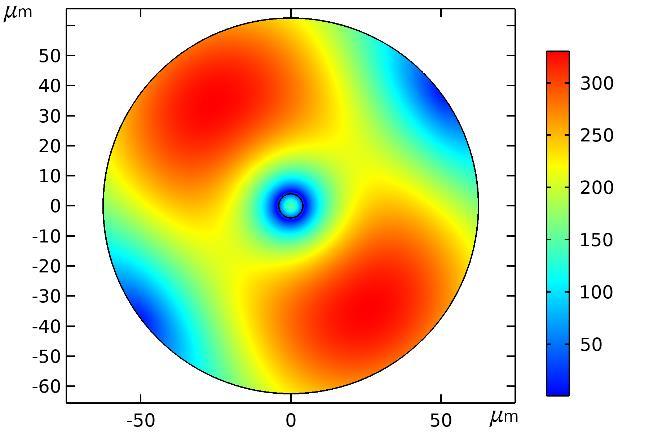
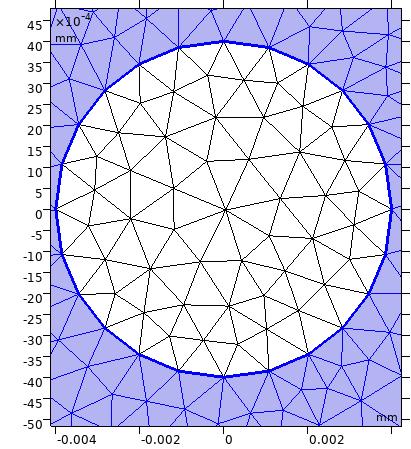
In this paper, the design of a layered FBG sensor using FEM and spectrum analysis with CMT produces an optimal temperature sensor in terms of sensitivity, the distribution of the electric field around the core and cladding is investigated, then observed the effect of the coefficient of thermal expansion on the Bragg wavelength shift and compares it with research done before. PMMA has a thickness of 20 µm after the cladding layer, high sensitivity will provide good performance in measuring temperature, a significant shift in the Bragg wavelength indicates the FBG is performing well. The simulation was carried out using the FEM method based on Comsol Multiphysics 5.6 software, after parameter definition and 2D geometry design of the FBG profile, the work continued with defining the FBG material based on the refractive index of each material, The simulation is carried out by investigating 2D surfaces, the first layer is a core made of silica, the second layer of cladding is also made of silica, then the coating material is PMMA. After investigating the electric field around the layer as shown in Figure 3(a) PMM-coated FBG cross-section and Figure 3(b) electric field distribution graph around the FBG cross-section
The Figure 3 shows the distribution of electric fields for two different effective refractive indexes, based on the FEM so that it can model propagation behavior on FBG coating. For the effectiveness index of each fiber optic material, it is shown that the electric field around the fiber surface with the highest electric field magnitude is 400 V/m. FBG coating has a thickness of 20 μm for core materials and the cladding is silica, while the coating materials are PMMA. The wavelength used in the simulation is 1550 nm, FEM can show the effective refractive index of each FBG coating design, the value of the effectiveness refractive index will affect the sensitivity of FBG coating as in (4), while for the electric field distribution graph around the surface of the fiber optic for different materials addressed in Figure 4.
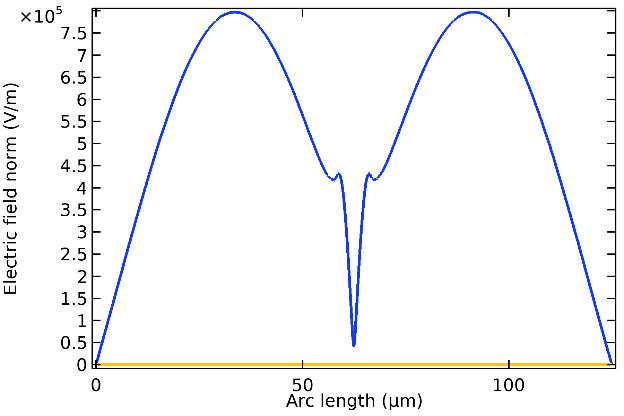

An important parameter of an optical sensor is a very sensitive response to changes in the environment, such as temperature. In FBG the coefficient of thermal expansion is directly proportional to the shift in the Braag wavelength. In this study, FBG was tested with a temperature range of 25 ℃ to 85 ℃. After defined and testing for each temperature change, the Bragg wavelength shift was obtained in Figure 4(a) and the effect of the coefficient of thermal expansion on the wavelength in Figure 4(b).
Figure 4 shows the linear increment of the Bragg wavelength to the change of temperature (a) and to the thermal expansion (b). This yields a good results, although the gradient of each material determines the sensitivity of each material. FBG coating has Bragg wavelengths that shift to temperature changes, this shift dependency is on the thermo optic coefficient and the thermal expansion coefficient of each material, materials with negative thermo optical coefficient values will make the FBG reflection spectrum move to the left from the center of the wavelength as well as in turn. Each material designed for FBG coating shows the linearity of the shift in Bragg wavelength to the temperature change, in this case the temperature range used was 25 ℃ 85 ℃, the same treatment was shown in all coating materials. The sensitivity of each coating material PMMA 395.73 (pm/℃).

Above it is explained that the magnitude of the coefficient of thermal expansion of each material is directly proportional to the resulting Bragg wave shift, the larger the Bragg wave shift will enhance the FBG performance well and be able to easily define a very small temperatures measurement. This result allows FBG for application at very small temperature changes because for a temperature change of 1 ℃ PMMA coated FBG is able to shift the Bragg wavelength as far as 395.73 pm. Figure 4(b) shows the relationship between the coefficient of thermal expansion and the wavelength, the relationship is linear, this graph is obtained at a temperature of 25 ℃. In Figure 4(a) we can see that if we compare it with different materials such as aluminum and silica, the slope gradient of FBG with PMMA layer is larger and this gives an idea that FBG with PMMA layer has good sensitivity.
The transmission and reflection spectra of FBGs are obtained because of the behavior of FBGs that can filter certain wavelengths, wavelengths are filtered because FBGs have a grating whose refractive index changes periodically. In this design, the FBG uses a uniform grating with a core material and cladding in the form of silica, then the FBG is coated with PMMA material. After the simulation process is carried out, Figure 5 shows the reflection spectrum of PMMA-coated FBG with respect to temperature changes and Figure 6 shows a shift in the reflection spectrum of silica-coated FBG with respect to temperature changes.
Bragg-wavelengths shift varies linearly to temperature. Figure 4 shows the significant sensitivity difference of FBGs with each coating material. However, FBG coated with PMMA material provides the greatest shift at a 25 ℃, The two wavelengths of the coating material are at a wavelength of 1550 nm after the temperature is increased to 10 ℃ the shift of the two wavelengths shows different results. PMMA coated
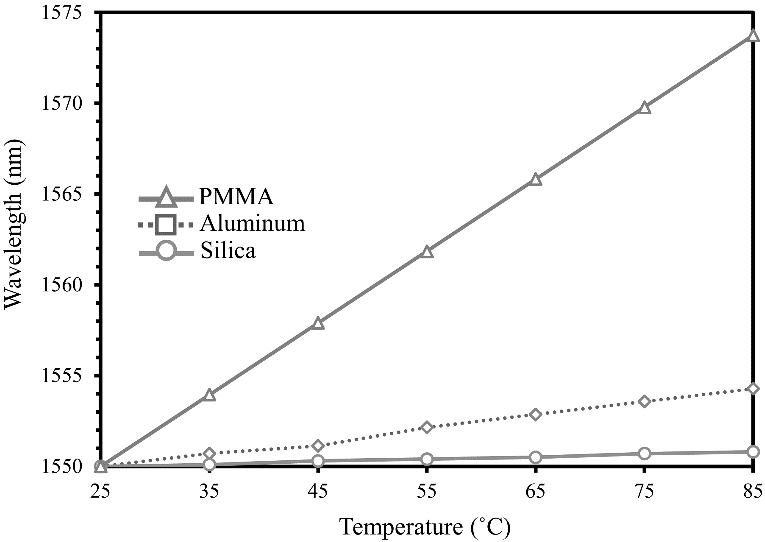
FBG at a temperature of 35 ℃ has a Bragg wavelength which is at 1553.95 nm experiencing a shift of 3.95 nm. This increase is linear for every 10 ℃ increases if we look at the shift in the Bragg wavelength for silica materials at a 35 ℃, the wavelength peak is at 1550.13 nm or experiences a shift of 0.13 nm. This is much smaller when compared to shift experienced by PMMA coated FBG. Physically it can be explained by the large coefficient of thermal expansion of the PMMA material directly proportional to the shift in the Bragg wavelength as shown in (4), that the coefficient of thermal expansion of the FBG coating material is directly proportional to the shift in the Bragg wavelength which shows the ability of the FBG to monitor the temperature and so on for temperatures of 25 to 85 ℃ which are the measurement limits in this study. PMMA coated FBG has good linearity in temperature measurement and has a large wavelength shift. At the temperature limit of 85 ℃ PMMA coated FBG has a Bragg wavelength of 1573,744 nm compared to Silica material at a wavelength of 1550.8 nm. So that along the temperature of 25 ℃ to 85 ℃ PMMA coated FBG experienced a shift of 23,744 nm while silica FBG was 0.8 nm. The following is a comparison of the performance of layered FBG with previous studies in Table 2 which we can see a comparison with previous research, that PMMA-coated FBG with a thickness of 20 µm and a grating length of 4000 µm has the highest sensitivity to temperature in the range of 25 85 ℃.
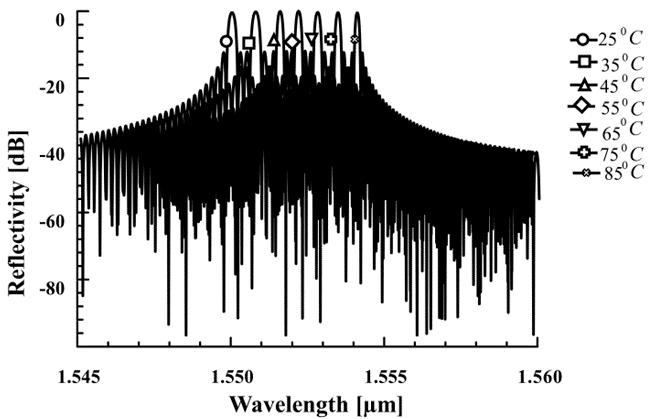
PMMA-coated FBG for temperature measurement
s was almost twice [26]
Sensitivity is 395.73 pm/℃. With 20 µm coating thickness and 4000 µm grating length. Temperature range 25 to 85 ℃ This study
In this paper we design the PMMA coated FBG using the FEM, the electric field distribution on the profile of the core, cladding, and coated FBG is obtained. Then by using CMT on the coated-FBG, the transmission and reflection spectrum and wavelength shift were obtained, the PMMA coated FBG shifted by 395.73 pm for a change of 1℃ temperature. This result is very good compared to silica FBG with a shift of 13.73 pm. these results indicate that layered FBG can increase the shift of the wavelength and has a good ability as a temperature sensor.
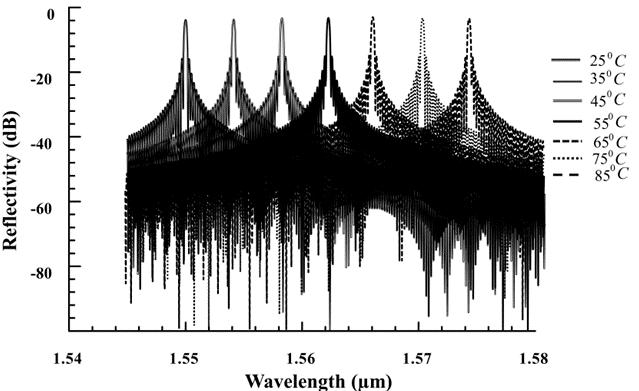
We would like to thank LPPM Universitas Riau for their great support in this research under DRTPM Desentralisasi with contract no. 1643/UN19.5.1.3/PT.01.03/2022. We also would like to thank Optics and Optoelectronics laboratory and plasma and photonics physics laboratory
[1] G. Chen, L. Liu, H. Jia, J. Yu, L. Xu, and W. Wang, “Simultaneous strain and temperature measurements with fiber bragg grating written in novel Hi-Bi opticalfiber,” IEEE Photonics Technology Letters,vol.16,no.1,pp.221–223,2004,doi:10.1109/LPT.2003.820117.
[2] A. G. L -Junior, C. A. R. Diaz, L. M. Avellar, M. J. Pontes, C. Marques, and A. Frizera, “Polymer optical fiber sensors in healthcare applications: A comprehensive review,” Sensors, vol. 19, no. 14, 2019, doi: 10.3390/s19143156.
[3] G. M. Ma, C. R. Li, J. T. Quan, J. Jiang, and Y. C. Cheng, “A fiber bragg grating tension and tilt sensor applied to icing
388
ISSN: 1693-6930
monitoring on overhead transmission lines,” IEEE Transactions on Power Delivery, vol. 26, no. 4, pp. 2163–2170, 2011, doi: 10.1109/TPWRD.2011.2157947.
[4] D. Irawan, Saktioto, J. Ali, M. Fadhali, and Erwin, “Estimation of coupling parameters for auto-motorized fabrication of fused fiber coupler,” Microwave and Optical Technology Letters, vol. 54, no. 8, pp. 1932–1935, 2012, doi: 10.1002/mop.26937.
[5] D. Irawan, T. Saktioto, Iwantono, Minarni, Juandi, and J. Ali, “An optimum design of fused silica directional fiber coupler,” Optik, vol. 126, no. 6, pp. 640–644, 2015, doi: 10.1016/j.ijleo.2015.01.031.
[6] S. Sharma and A. Kumar, “Analysis of silica based single-mode fiber doped with germanium at different transmission window,” Silicon, vol. 14, pp. 1023–1028, 2022, doi: 10.1007/s12633-020-00884-6.
[7] C. Lupi et al., “Critical issues of double-metal layer coating on FBG for applications at high temperatures,” Sensors, vol. 19, no. 18, 2019, doi: 10.3390/s19183824.
[8] P. J. Rivero, J. Goicoechea, and F. J. Arregui, “Optical fiber sensors based on polymeric sensitive coatings,” Polymers, vol. 10, no. 3, 2018, doi: 10.3390/polym10030280.
[9] B. Zhang and M. Kahrizi, “High-temperature resistance fiber bragg grating temperature sensor fabrication,” IEEE Sensors Journal, vol. 7, no. 4, pp. 586–591, 2007, doi: 10.1109/JSEN.2007.891941.
[10] W. Bai, M. Yang, J. Dai, H. Yu, G. Wang, and C. Qi, “Novel polyimide coated fiber bragg grating sensing network for relative humidity measurements,” Optics Express, vol. 24, no. 4, pp. 3230-3237, 2016, doi: 10.1364/OE.24.003230.
[11] F. Scurti, J. McGarrahan, and J. Schwartz, “Effects of metallic coatings on the thermal sensitivity of optical fiber sensors at cryogenic temperatures,” Optical Materials Express, vol. 7, no. 6, pp. 1754–1766, 2017, doi: 10.1364/OME.7.001754.
[12] C. -Y. Hsu, C. -C. Chiang, T. -S. Hsieh, H. -C. Hsu, L. Tsai, and C. -H. Hou, “Study of fiber Bragg gratings with TiN-coated for cryogenic temperature measurement,” Optics & Laser Technology, vol. 136, 2021, doi: 10.1016/j.optlastec.2020.106768.
[13] R. B. Blackman, J. W. Tukey, and T. Teichmann, “The measurement of power spectra,” Physics Today, vol. 13, no. 2, 1960, doi: 10.1063/1.3056826.
[14] M. Rosenberger et al., “High temperature stable polymer planar waveguide Bragg grating sensors,” in 2018 IEEE 7th International Conference on Photonics (ICP), 2018, pp. 1–3, doi: 10.1109/ICP.2018.8533163.
[15] X. Lu, P. J. Thomas, and J. O. Hellevang, “A review of methods for fibre-optic distributed chemical sensing,” Sensors, vol. 19, no. 13, 2019, doi: 10.3390/s19132876.
[16] T. Saktioto, K. Ramadhan, Y. Soerbakti, D. Irawan, and Okfalisa, “Integration of chirping and apodization of Topas materials for improving the performance of fiber bragg grating sensors,” Journal of Physics: Conference Series, 2021, vol. 2049, doi: 10.1088/17426596/2049/1/012001.
[17] T. Saktioto, K. Ramadhan, Y. Soerbakti, R. F. Syahputra, D. Irawan, and O. Okfalisa, “Apodization sensor performance for Topas fiber bragg grating,” TELKOMNIKA (Telecommunication Computing Electronics and Control), vol. 19, no. 6, pp. 1982
1991, 2021, doi: 10.12928/telkomnika.v19i6.21669.
[18] D. Irawan, K. Ramadhan, Saktioto, and A. Marwin, “Performance comparison of Topas chirped fiber bragg grating sensor with tanh and gaussian apodization,” Indonesian Journal of Electrical Engineering and Computer Science, vol. 26, no. 3, pp. 1477
1485, 2022, doi: 10.11591/ijeecs.v26.i3.pp1477-1485.
[19] L. Coelho, D. Viegas, J. L. Santos, and J. M. M. M. de Almeida, “Characterization of zinc oxide coated optical fiber long period gratings with improved refractive index sensing properties,” Sensors and Actuators B: Chemical, vol. 223, pp. 45
51, 2016, doi: 10.1016/j.snb.2015.09.061.
[20] K. S. C. Kuang, R. Kenny, M. P. Whelan, W. J. Cantwell, and P. R. Chalker, “Embedded fibre bragg grating sensors in advanced compositematerials,” Composites Science and Technology,vol.61,no.10,pp.1379–1387,2001,doi:10.1016/S0266-3538(01)00037-9.
[21] V. Mishra, M. Lohar, and A. Amphawan, “Improvement in temperature sensitivity of FBG by coating of different materials,” Optik, vol. 127, no. 2, pp. 825–828, 2016, doi: 10.1016/j.ijleo.2015.10.014.
[22] D. Sengupta, M. S. Shankar, P. S. Reddy, R. L. N. S Prasad, K. S. Narayana, and P. Kishore, “An improved low temperature sensing usingPMMAcoated FBG,”in Asia Communications and Photonics Conference and Exhibition (ACP),2011,doi:10.1117/12.904606.
[23] T. Erodgan, “Fiber Grating Spectra,” Journal of Lightwave Technology, vol. 15, no. 8, pp. 1277–1294, 1997, doi: 10.1109/50.618322.
[24] L. Schenato, “Fiber-optic sensors for geo-hydrological applications: basic concepts and applications,” Rendiconti online della Società Geologica Italiana, vol. 30, pp. 51–54, 2014. [Online]. Available: https://www.researchgate.net/publication/314441124_FiberOptic_Sensors_for_Geo-Hydrological_Applications_basic_concepts_and_applications
[25] M. Latino, R. Montanini, N. Donato, and G. Neri, “Ethanol sensing properties of PMMA-coated fiber bragg grating,” Procedia Engineering, vol. 47, pp. 1263–1266, 2012, doi: 10.1016/j.proeng.2012.09.383.
[26] A. Quattrocchi, R. Montanini, M. Latino, and N. Donato, “PMMA-coated fiber bragg grating sensor for measurement of ethanol in liquid solution:manufacturingand metrological evaluation,” ACTA IMEKO, vol.10,no.2,2021,doi:10.21014/acta_imeko.v10i2.1052
Dedi Irawan is a lecturer at Physics Education, Dept. of Education of Mathematics and Natural Sciences, Universitas Riau, Pekanbaru, Indonesia. He works on basic and advanced Photonics. He has published many articles and supervised Master degree and Doctoral degree since 2015 in Universitas Teknologi Malaysia. Curently research focus in fiber bragg grating sensor (FBG), Mach-zehnder Interferometer. Furthermore, he is also doing some research in optoelectronic and optical sensor utilizing FBG, MZI, and directional coupler for medical and agricultural application. He can be contacted at email: dedi.irawan@lecturer.unri.ac.id.

Khaikal Ramadhan was a student at the University of Riau in 2017 and has finished studying Physics at the University of Riau with a B.Sc degree in 2021. He interests include applied physics, Phontonics, Optical Fiber for communication and sensor. currently joint research focus in Fiber bragg grating sensor, MZI, PCF-SPR. He can be contacted at email: khaikal.ramadhan4946@student.unri.ac.id.
Toto Saktioto is a Senior lecturer at Physics Dept., Faculty of Mathematics and Natural Sciences, Universitas Riau, Pekanbaru, Indonesia. He works on Plasma and Photonics Physics. He has published numbers of article in indexed journal reporting his work in plasma photonic, and it’s related with fiber coupler fabrication. He also active doing supervision in Master and Doctoral degree since 2009. Currently his research focus is photonics and plasma industry for communication and biosensors. He can be contacted at email: saktioto@yahoo.com.


Azwir Marwin was a student at the University of Riau in 2019. His interests include applied physics, pure physics. Now he works on optoelectronics laboratory as laboratory assistant. And also joint with research focus in Fiber bragg grating sensor, Mach-zehnder interferometer. He can be contactetabled at email: azwir.marwin4971@student.unri.ac.id.
